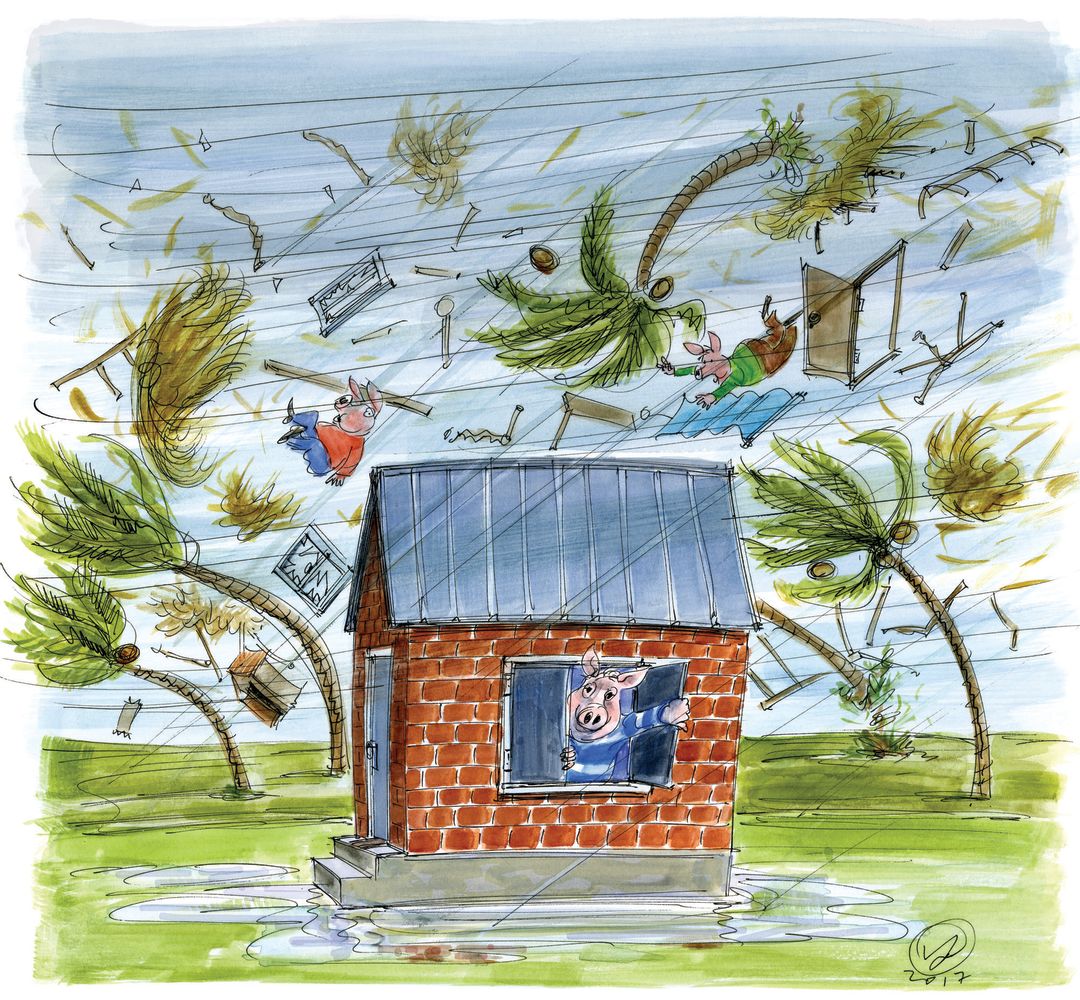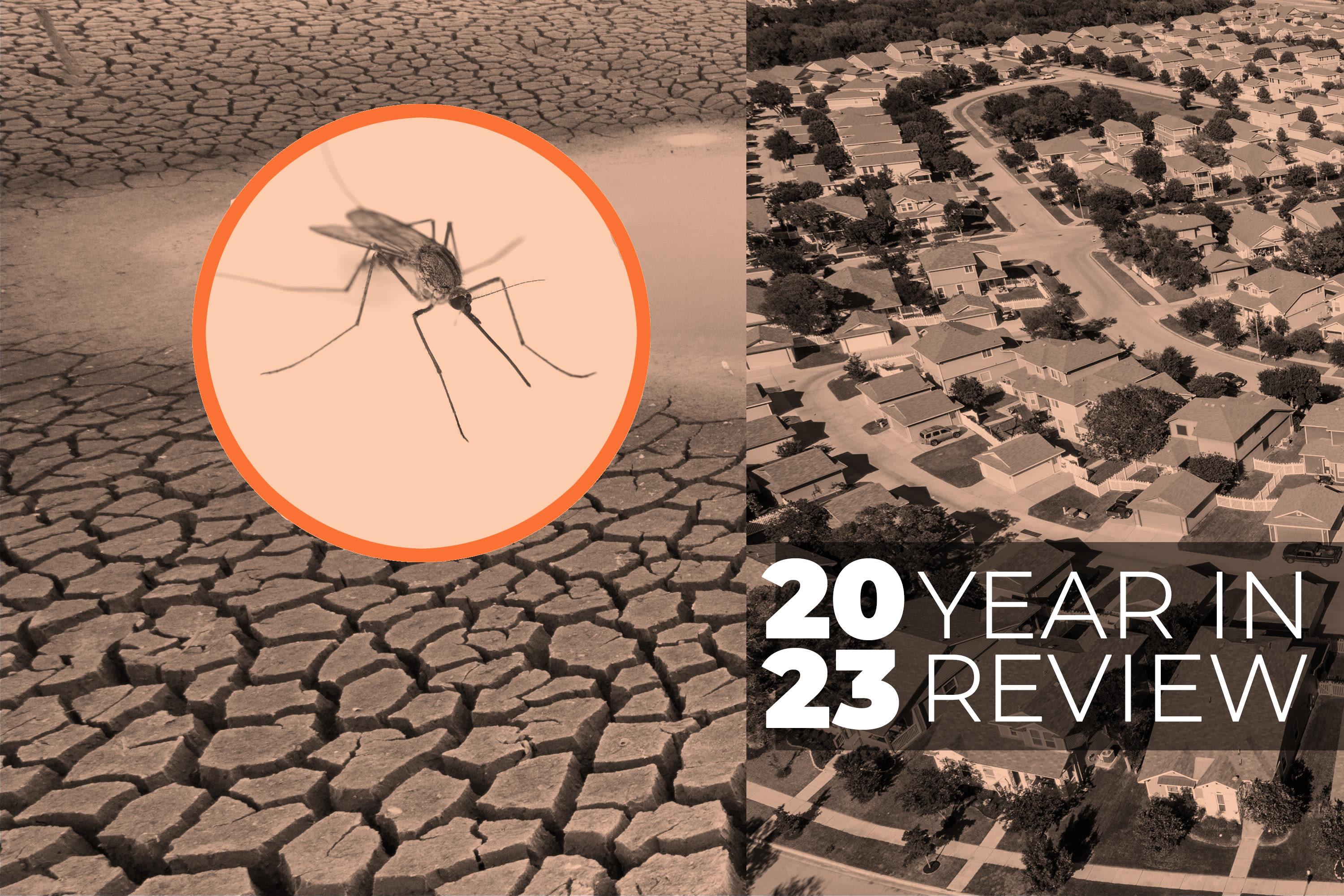How Your Business Can Survive a Natural Disaster

Image: Victor Juhasz
When Category 4 Hurricane Charley roared through Punta Gorda on Aug. 13, 2004, Kevin Doyle, his son and five customers were holed up in the men’s bathroom of Doyle’s Irish pub, Celtic Ray. When they emerged, Doyle saw the plate glass windows of his business lying in pieces across the street. The roof of the two-story building was gone. Water dripped down the walls. “It looked like a war zone,” he says. Doyle remembers thinking, “We can’t recover. We can’t rebuild and replenish our stock. We’re too broke for that. We’re going to have to close.”
Almost 13 years later, Doyle’s Celtic Ray is thriving. He purchased the building from his landlord, expanded the pub to the second floor and was named by Travel + Leisure this year as the No. 2 pub in in the country for St. Patrick’s Day celebrations.
“Can you make more of those videos?” he asked the storm junkies as he served them beer. “I have a proposition to make. I’ll buy 500 for $12 apiece and we’ll sell them for $20. I’ll get a story in the paper. I want to be the only retail spot for these. You can have phone orders.” They sealed the deal on a handshake, he says.
The next day, the local paper ran a front-page story about the DVDs. Within a few days, Doyle sold 8,000 copies and made $64,000. “Enough profit to dry the building and put in the new windows,” he says.
He replaced all his windows and doors with impact-resistant products. He’s caulked every surface he could think of to ward off water damage. His new bathrooms are safe rooms. He has a generator in case the electricity goes out. And Celtic Ray has a staff Facebook page so he can communicate with all his employees in case of a disaster.
Doyle is more prepared today because he knows what it’s like to ride out a hurricane and rebuild. But most business owners in Sarasota and Manatee have never experienced a major storm. Since 2004, no hurricane has made a direct hit on Florida.
FEMA estimates that 40 to 60 percent of small businesses do not reopen after a disaster. That number rises to 90 percent if the company doesn’t reopen within five days. The latest hurricane to hit the U.S., Hurricane Matthew, caused an estimated $6 billion in damage from Florida to North Carolina. FEMA found that mitigation saves businesses an average of $4 for every $1 spent.
And for some industries, such as financial services or any company that deals with hazardous chemicals, having a preparedness plan is the law.
Every business needs a plan not only for preparing for a hurricane or other natural disaster, but also to guide employees dealing with the aftermath. Here’s how to prepare before, during and after a natural disaster.
Before: Make a Plan
Businesses should form a team to put together a standard business impact analysis (BIA) that tells bosses and employees how prepared the company is to handle a disruption, says Jessica Markun, director, Internal Audit, for Sarasota-based FCCI Insurance Group. Markun heads up FCCI’s internal Business Continuity Management group, which ensures that clients are prepared for a disaster.
That team should consist of these members:
• Employees in charge of critical operations
• Employees in charge of resources
• Stakeholders, other than employees
• Risk managers/insurance agents
A BIA identifies vulnerabilities in a company in the case of a disaster and key processes to minimize impact to the business, its employees and its customers. First concern: Keep everyone safe.
Getting small businesses to focus on disaster planning is difficult, says Bruno Kapacinskas, business resource manager for Manatee County, who put on a disaster planning expo for local businesses last month. “They’re more concerned about just keeping the doors open,” he says.
Fortunately, businesses don’t have to reinvent the wheel. Templates on numerous sites (see page 20) provide disaster preparedness checklists, and Sarasota and Manatee counties have their own emergency management offices that have guidelines online. Find the template that seems best for your industry and customize.
“Training on the plan, using multiple scenarios [hurricane, system outage, pandemic, etc.] are key,” Markun says. “Making sure people know what they’re supposed to do before, during and after an event, as well as what they’re not supposed to do is vital.” Businesses should review this plan annually.
James Rivera, associate administrator for the U.S. Small Business Administration’s Office of Disaster Assistance in Washington, D.C., says planning also needs to run the length of a supply chain.
In the event your suppliers can’t ship to you, a good disaster preparedness plan will include backup vendors that can supply your business. You may also want to identify other businesses that could temporarily supply your customers until you get up and running again.
FCCI advises business owners to find a licensed agent they trust to recommend products to help mitigate their specific risks. FEMA reports that 18 percent of businesses say that their biggest problem was uninsured losses, particularly those that pertained to continuing operations rather than property damage. Inquire about insurance types beyond the standard general liability and property policies.
Businesses also should build in redundancy before a disaster. Make sure insurance policies, contracts and employee records can be accessed in case an office is closed or damaged. IT should make and store copies of disks, software and hardware licensing, and all serial numbers of equipment.
“We have more digital tools than we did before,” says Sherilyn Burris, the chief at Manatee County Emergency Management. “Take pictures of your belongings on your phone, use digital documentation. When you make a claim, you can show what your business looked like before the storm.”
Kim Campanella, owner of the Bicycle Center in Port Charlotte, is another Hurricane Charley survivor. Her shop was demolished in the storm, and she ran her business out of shipping containers without air conditioning for years afterwards before she could get the loans to rebuild. Campanella, honored as a Distinguished Entrepreneur by Florida Gulf Coast University a few years ago, is now in her own 6,000-square-foot building, has five employees and more than $1.4 million in sales. “Business is really good now,” she says.
But she’s now also extremely conscious of preparing for a disaster.
“I’m hyperalert,” she says. “I have impact windows. We photograph our inventory, and I make sure everything is over-insured. I insure our property, but I’ve got loss of income insurance as well.”
And in case of another hurricane, she’s made sure she’ll have product to sell. “I have more suppliers today,” she says.
Businesses also need to create a crisis communication plan. Every employee should know where they’re expected to go, with whom they’re expected to communicate, and from whom they should expect to receive direction.

Image: Victor Juhasz
During: Safety First
During any disaster, employee safety should be every business owner’s priority.
Florida businesses face two types of potential disasters. No-notice events can include tornadoes, massive power outages, flash floods or even a terrorist attack. And then there are trackable storms and hurricanes, which give businesses some time to prepare and communicate with their employees.
For a no-notice event, “businesses should gather employees in a safe area in the facility until the threat passes,” Alberto Moscoso, communications director for the Tallahassee-based Florida Division of Emergency Management, says. “A safe area may include an interior room with no windows, a reinforced room, a closet, or a bathroom on a lower floor.” Employees should use the stairs and stay away from windows, glass doors and skylights. If needed, they should crouch to make themselves smaller targets and protect their heads from projectiles.
When a hurricane approaches, employers should review the BIA with employees so their roles and responsibilities are fresh in their minds.
“This should keep employees informed of potential alternate work locations, plans for remote operations, information on the business disaster supply kits, and the closing date and time before the storm,” Moscoso says. “Ensure that employees have ample time after closing the business to secure their own homes and families, acquire any necessary supplies, and evacuate if necessary.”
During a disaster, your BIA’s internal communications plan is essential to keeping tabs on employees’ whereabouts and safety needs. Rivera says social media can be your friend. Whether you set up a Facebook group or use a group messaging mobile app like WhatsApp, Facebook Messenger, Groupme or WeChat, find what works best for everyone in your company. Have a point person who manages it during the disaster to check in with team members and ensure their safety.
If an employee isn’t responding to the group text or individual calls and messages, the communications point person should reach out to emergency personnel for a wellness check.
Markun says you can’t overcommunicate during a hurricane. Her company, FCCI Insurance Group, starts monitoring storms once they have been named. That’s followed by corporatewide communications on status, tracking and impacts once they’ve determined whether any regional offices are in the long-range cone of uncertainty.
“Our crisis team will engage and start discussing possible courses of action approximately five days before a potential landfall,” she says.
It’s also critical to heed emergency management officials’ warnings when faced with a storm. If an evacuation is ordered, and the business is located within the evacuation zone, emergency responders will be unable to respond during the disaster.
If your business is located outside the evacuation zone, it may serve as a shelter for you and fellow employees. “In that case, take necessary time to ensure that windows and doors are protected and secured and that business disaster supply kits are properly stocked with essential items, including a three-day supply of nonperishable foods and a gallon of water per day for each employee staying at the business,” Moscoso says.
After: Assess the Damage and Get Back to Business
Even in the immediate aftermath of a disaster, FCCI claims manager Mark Winters says a business owner’s priority should remain employee safety. Once all employees are accounted for and deemed safe, it’s time to assess the damage to the business.
Winters encourages business owners to prevent further damage to their business if it has been open to the elements. It’s up to the business owner whether he or she wants to tackle this project internally or hire a contractor to board up the business and secure the roof.
Contact your insurance agent, he says, and “take the time to document an insurance claim with photographs of the damage and lists of the contents that are damaged. This will be very helpful when the adjuster arrives to show the loss and the work done to date.”
If there is damage to your business, Winters urges business owners to work closely with their adjuster to understand their existing coverages and what the insurance company can pay for.
“[Insurance agents] can make recommendations such as engineers to assist with assessing the damage to a building and what it will take to repair the more significant damages,” he says.
Disaster response teams are available at the local, state and federal levels. They can connect you to resources to help mitigate your losses and get you back up and running.
Hopefully, copies of all important documents have been stored at an alternate location or in the cloud prior to the disaster. Accounting, production, property records and photos and/or videos of how the business looks without damage will be vital to helping loan officials assess your case.
“This should expedite recovery efforts without the hassle of trying to duplicate lost documents,” Moscoso says.
Once you’ve managed to get the business back up and running, it’s time to let the world know. Sixty-two percent of companies that have gone through a disaster say their major challenge was the loss of sales and customers, according to FEMA.
“What’s key for today’s business owners,” Rivera says, “is to update your social media accounts—Facebook, Twitter, Instagram, company blog—to alert your customers that you’re open for business.”
Hurricane survivor Doyle has this advice: “Don’t gouge. Open as soon as you can, even if it’s makeshift. If you can—serve, serve, serve.”
Pre-Hurricane Checklist
- Stay informed: Monitor local media and stay up‐to‐date on the storm's progress via radio, TV or NOAA Weather Radio All Hazards receiver.
- Review your shelter‐in‐place plan, making sure your disaster kit is fully stocked and fresh batteries & supplies are included. Talk to your employees to ensure they have a safe place to weather the storm.
- Ensure you have an emergency communication plan in place prior to the storm, evacuation, or threat. Have multiple emergency contacts for employees, vendors and other service providers essential to your day-to-day operation.
- Have copies of all vital records including insurance policies. Protect or relocate the originals. Back up all data on servers and personal computers. If the backup site is within the area that may be affected by the storm, take backup tapes with you in the evacuation.
- Review your company’s relocation plan should your location be inaccessible after impact. Ensure remote access to your company’s website so updates about your availability can be made. Forward phone lines, or know how to do so remotely if necessary.
- Have cash on hand for post‐impact needs, such as buying food and supplies, or paying employees and contractors.
- Fill fuel tanks of generators and any company owned vehicles.
Secure all equipment, indoors and outdoors:
Indoors
- Turn off all non‐critical devices such as server monitors and workstations and other non‐essential electrical equipment.
- Move electronics off the floor, if possible, to the highest possible level.
- Remove as many goods as possible from the floor, or ship them out of the facility.
Outdoors
- Remove all loose debris
- Anchor or relocate all nonessential equipment to a safe indoor location
- Make sure outdoor signs are properly braced
- Secure storage of flammable liquid drums, or move them to a sheltered area (but never into main facility areas)
- Anchor all portable buildings (e.g., trailers) to the ground
- Secure large cranes and other heavy equipment
Source: SBA
A Business Impact Plan Should Include
- Employee safety procedures and expectations
- Internal and external communications plans
- Customer support
- System backup and recovery
- Operations recovery
- Defined roles and responsibilities in the event of a disaster
- Workload shifting
- Communication with dispatched employees
- Workaround procedures, such as backup vendors or remote locations, for business processesDisaster Resources
- Ready.gov
- National Flood Insurance Program (FEMA.gov)
- American Red Cross Disaster Preparedness
- PrepareMyBusiness.org
- Florida Division of Emergency Management
- Manatee County Business Recovery Directory
- Sarasota County Business Disaster Plan
- --U.S. Small Business Administration Disaster Recovery Loan
- --Florida Small Business Emergency Bridge Loan, Disaster Unemployment Assistance program and Short Time Compensation program.



